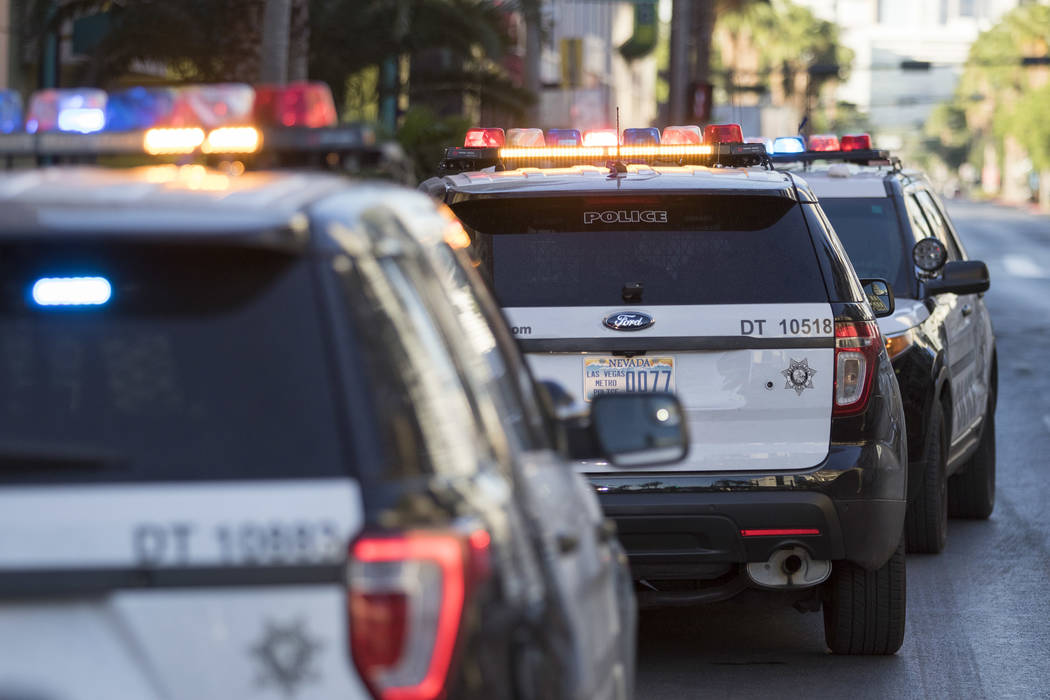Las Vegas police say violent crime decreased in 2017

The Metropolitan Police Department released its 2017 statistics Thursday and said they show a decrease in violent crime.
“We began last year committed to reducing violent crimes and we were able to deliver that promise,” Sheriff Joe Lombardo said in a statement. “We still have more ground to cover, but we’re headed in the right direction.”
According to the statement, Metro’s murder statistics did not include the 58 concertgoers who were fatally shot Oct. 1 on the Las Vegas Strip.
When asked why the massacre numbers were excluded, department spokesman Larry Hadfield said, “Federally, you don’t have to report because it’s a mass casualty event.”
The spokesman denied a request for an interview Thursday with Lombardo.
A tweet from the department announcing the “decrease in violent crime in 2017” quickly drew criticism. Some considered it insensitive.
“Um… the WORST shooting in American history took place in October. What?” one person wrote.
“This is an insult to this country and the people who died that night. Don’t pat yourselves on the back wow,” another wrote.
Metro followed up about an hour later with another tweet: “To elaborate, this information is not meant to discount the awful events of 1 October. These are annual statistics provided for comparative purposes. The results should be encouraging, especially considering the 83% homicide solve rate, much higher than many other jurisdictions.”
To elaborate, this information is not meant to discount the awful events of 1 October. These are annual statistics provided for comparative purposes. The results should be encouraging, especially considering the 83% homicide solve rate, much higher than many other jurisdictions. https://t.co/xYtzzmQ4qZ
— LVMPD (@LVMPD) January 18, 2018
The 141 murders the department reported to a federal crime database do not include those killed in the Oct. 1 shooting. According to Metro, the number represents a 10.2 percent drop in murders.
‘Isolated event’
Several elected officials who sit on the Metropolitan Police Committee on Fiscal Affairs, which oversees the department’s budget, supported the decision to exclude the mass shooting from the crime statistics.
“I do not believe they should include that in our regular violent crimes stats,” said Las Vegas City Councilman Stavros Anthony, a former Metro officer. “That was such an anomaly, such an isolated event.”
Clark County Commission Chairman Steve Sisolak said he believed it was fair for Metro to omit the Oct. 1 killings.
“The 1 October shooting was a one-time event that will hopefully never happen again,” Sisolak said. “It is not reflective of the crime statistics that affect the (Las Vegas) Valley on a monthly or annual basis … and for that reason I don’t think it should be included in that statistic.”
Clark County Commissioner Larry Brown said he did not believe Metro was trying to hide anything. The county uses Metro’s crime statistics to determine where additional services are needed, and the mass shooting would skew the numbers.
“I don’t think including 1 October is appropriate when we’re comparing criminal activity year after year,” Brown said.
Jaclyn Schildkraut, an assistant professor at State University of New York at Oswego who studies mass shootings, told the Review-Journal earlier this month that mass shootings should be viewed as outliers when looking at local crime statistics.
Mass shootings are not indicative of trends in violent crime, she said.
But Metro’s decision to exclude the 58 victims broke from what law enforcement officials in Orlando and San Bernardino did after mass shootings in each of those cities. Police departments in both cities included the mass shooting deaths in their reported murder totals.
‘A homicide is a homicide’
San Bernardino Police Department spokesman Lt. Mike Madden said the department included the 14 people killed in a shooting on Dec. 2, 2015, at a public health facility in the December 2015 homicide statistics it reported, albeit in a category separate from its other homicides that month.
“A homicide is a homicide,” he said Thursday.
Orlando police spokeswoman Michelle Guido said the department reported 84 murders in its 2016 statistics, including the 49 people killed inside the Pulse nightclub on June 12, 2016.
The FBI’s crime statistics database then included this footnote: “The 2016 murder offenses include those victims of the Pulse Nightclub incident; therefore, figures are not comparable to previous years’ data.”
According to a 2014 story in USA Today, mass killings often go missing in FBI murder data.
Sandra Breault, a spokeswoman with the FBI’s Las Vegas field office, said all reporting is voluntary.
According to Metro’s statistics, the department saw an 11.3 percent decrease in robberies from 2016. However, rapes increased last year by 8.4 percent and aggravated assaults increased by 4.8 percent.
Overall, the total number of violent crimes — including murder, robbery, rape and aggravated assault — dropped by 0.9 percent, the department said.
The Review-Journal reported earlier this month that 2017 was a record-breaking year for homicides in Metro’s jurisdiction with 171 cases investigated, not including victims of the Oct. 1 massacre. The newspaper counts all homicides in its reporting, but Metro does not include instances of justifiable homicides.
Contact Blake Apgar at bapgar@reviewjournal.com or 702-387-5298. Follow @blakeapgar on Twitter. Contact Mike Shoro at mshoro@reviewjournal.com or 702-387-5290. Follow @mike_shoro on Twitter. Review-Journal staff writers Rachel Crosby, Michael Scott Davidson and Jamie Munks contributed to this story.